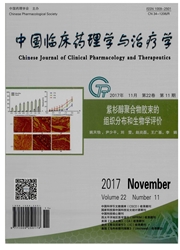

 中文摘要:
中文摘要:
目的:观察胍丁胺对福尔马林致炎性疼痛的镇痛作用,并研究其镇痛作用是否与影响脊髓磷酸化细胞外信号调节激酶(phosphorylated extracellular signal-regulated protein kinase,pERK)表达有关。方法:雄性SD大鼠,180~220g,随机分为生理盐水对照组、福尔马林组和胍丁胺160mg/kg组,每组20只。每组12只右侧足底皮下注射5%的福尔马林50μL致痛,每5min为一个时间段,测定60min内大鼠的痛级均数。另外每组8只足底注射福尔马林后8min取L4,5脊髓,用免疫组化法检测各组脊髓切片中pERK的表达情况。结果:大鼠单侧足底注射5%福尔马林50μL后出现明显的两期伤害性行为反应。胍丁胺对福尔马林引起的疼痛反应有明显的镇痛作用,且能抑制福尔马林引起的痛觉过敏。福尔马林对大鼠单侧足底注射8min后,引起注射侧L4,5脊髓背角pERK表达量升高,160mg/kg胍丁胺(i.p.)明显抑制福尔马林引起的pERK表达量的升高。结论:胍丁胺对福尔马林引起的疼痛及痛觉过敏行为有明确的抑制作用,炎性疼痛引起脊髓pERK蛋白表达升高可能参与疼痛及痛觉过敏的形成,pERK可能参与了胍丁胺镇痛机制。
 英文摘要:
英文摘要:
AIM:To evaluate the analgesic effect of agmatine on the model of formalin-evoked nociception;To investigate the changes in the expression of phosphorylated extracellular signal-regulated protein kinase(pERK) in the spinal dorsal horn of the formalin-induced inflammatory pain and the effect of agmatine on the pERK expression.METHODS:Male SD rats weighing 180-220 g were randomly classified into saline control group,formalin group,and agmatine group n=20.Rats were injected subcutaneously with 50 μL of 5% formalin solution into the plantar surface of the right hind paw.During the next 60 min,the weighted pain score was recorded in 5-min intervals for 12 rats/group.Another 8 rats/group were decapitated at 8 min after intraplantar injection and L4,5 spinal cords were dissected and coronal sections were cut.Immunohistochemistry was used to observe the changes of pERK expression in the dorsal horn of spinal cord.RESULTS:Intraplantar injection of formalin produced a typical biphasic nociceptive response.Intraperitoneally pretreatment with agmatine inhibited the nociceptive and hyperalgesic response.Injection of 5% formalin subcutaneously in the hindpaw of rats induced an increase in pERK expression in neurons in the superficial dorsal horn on the ipsilateral side of the L4,5 spinal cord.Pretreatment with 160 mg/kg agmatine significantly inhibited formalin-induced spinal pERK expression.CONCLUSION:Agmatine induces analgesia in the formalin-induced nociception.pERK activation may underlie spinal nociceptive processing and secondary hyperalgesia after formalin inflammation and may contribute to the analgesic effects of agmatine.
 同期刊论文项目
同期刊论文项目
 同项目期刊论文
同项目期刊论文
 期刊信息
期刊信息
